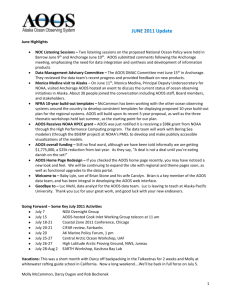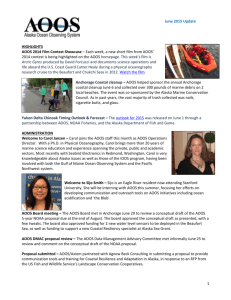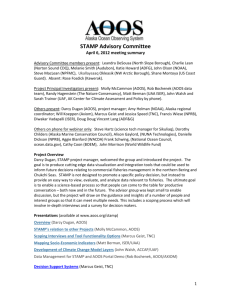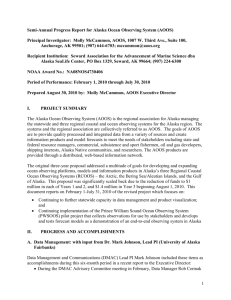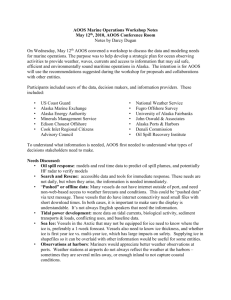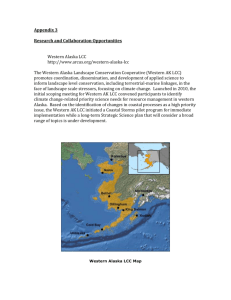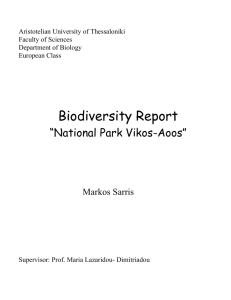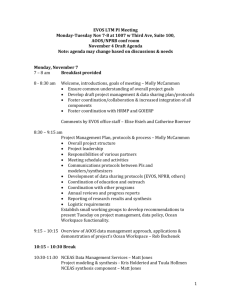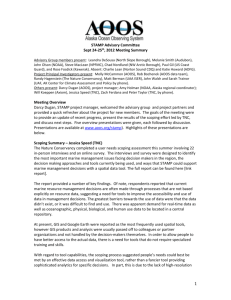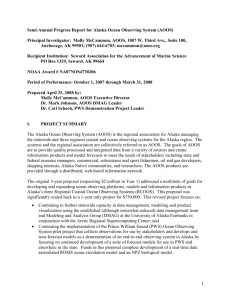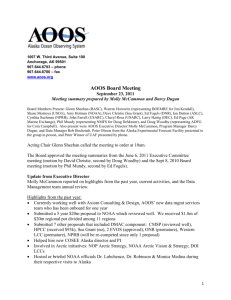AK modeling strategy workshop January 22, 2014 lunch at AMSS
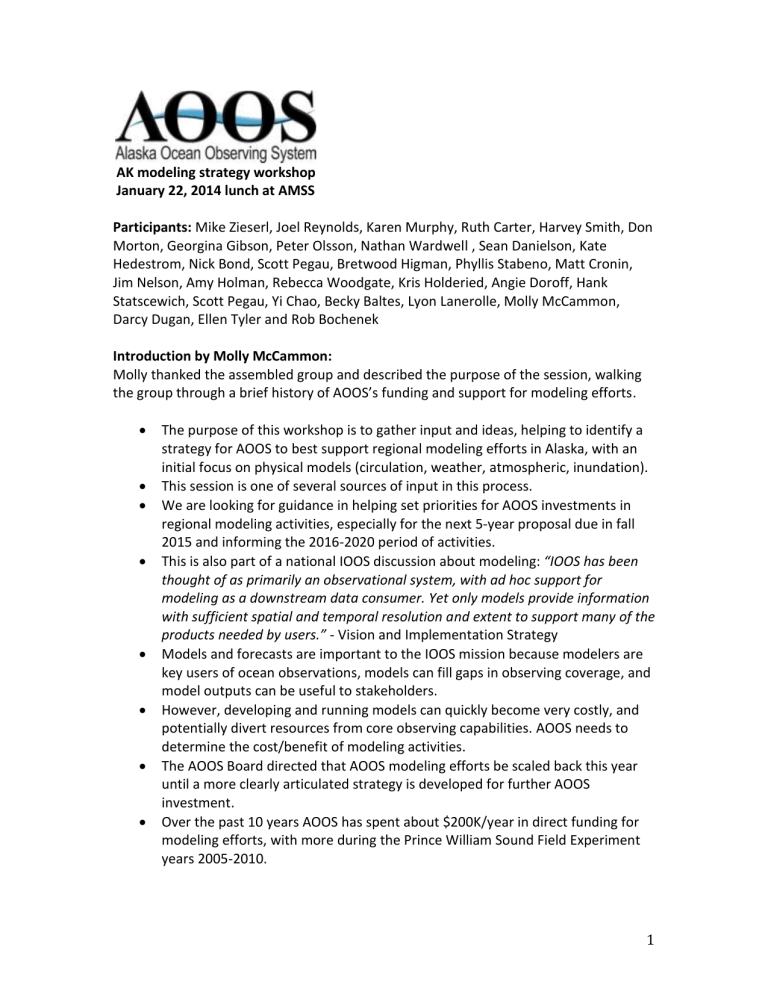
AK modeling strategy workshop
January 22, 2014 lunch at AMSS
Participants: Mike Zieserl, Joel Reynolds, Karen Murphy, Ruth Carter, Harvey Smith, Don
Morton, Georgina Gibson, Peter Olsson, Nathan Wardwell , Sean Danielson, Kate
Hedestrom, Nick Bond, Scott Pegau, Bretwood Higman, Phyllis Stabeno, Matt Cronin,
Jim Nelson, Amy Holman, Rebecca Woodgate, Kris Holderied, Angie Doroff, Hank
Statscewich, Scott Pegau, Yi Chao, Becky Baltes, Lyon Lanerolle, Molly McCammon,
Darcy Dugan, Ellen Tyler and Rob Bochenek
Introduction by Molly McCammon:
Molly thanked the assembled group and described the purpose of the session, walking the group through a brief history of AOOS’s funding and support for modeling efforts.
The purpose of this workshop is to gather input and ideas, helping to identify a strategy for AOOS to best support regional modeling efforts in Alaska, with an initial focus on physical models (circulation, weather, atmospheric, inundation).
This session is one of several sources of input in this process.
We are looking for guidance in helping set priorities for AOOS investments in regional modeling activities, especially for the next 5-year proposal due in fall
2015 and informing the 2016-2020 period of activities.
This is also part of a national IOOS discussion about modeling: “IOOS has been thought of as primarily an observational system, with ad hoc support for modeling as a downstream data consumer. Yet only models provide information with sufficient spatial and temporal resolution and extent to support many of the
products needed by users.” - Vision and Implementation Strategy
Models and forecasts are important to the IOOS mission because modelers are key users of ocean observations, models can fill gaps in observing coverage, and model outputs can be useful to stakeholders.
However, developing and running models can quickly become very costly, and potentially divert resources from core observing capabilities. AOOS needs to determine the cost/benefit of modeling activities.
The AOOS Board directed that AOOS modeling efforts be scaled back this year until a more clearly articulated strategy is developed for further AOOS investment.
Over the past 10 years AOOS has spent about $200K/year in direct funding for modeling efforts, with more during the Prince William Sound Field Experiment years 2005-2010.
1
When AOOS was funded through earmarks there was an assumption that funding would increase over time. Now with flat funding in the foreseeable future, AOOS is looking strategically at how to best allocate that ~10% of the total budget dedicated to a range of modeling activities:
Past direct investments in modeling:
• 2005-06: UAF Modeling & Analysis Center: $520k, modeling comparisons for sea ice, RAMS & ROMS
• 2005-06: Moorings & sensors in Southeast, Aleutian Island passes & Bering Strait to support developing circulation models
• 2005-2010: PWS Demonstration Project; ROMS, WRF, NPZ & SWAN models; about $250-300k a year
Current direct investments in modeling:
• PWS 24/7 ROMS ($100k/year) – Yi Chao
• GOA PWS & CI WRF ($100k/year) – Peter Olssen
• PWS hydrological model validation ($75k over 3 years) – Scott Pegau
• GOA ocean acidification model ($100k for1 year) – Jeremy Mathis
• Downscaled ocean climate models ($125k over 2 years) – John Walsh
Indirect support for modeling efforts:
Cook Inlet Modeling workgroup – networking, facilitating dialogue led to support for NOAA NCOS ROMS modeling effort
Observations for modeling purposes o Wave obs into Wavewatch model & storminess model o Industry obs into weather service forcasts o Beaufort Sea: obs to validate NCEP wave model
Adding value to existing models o AOOS Model Explorer provides easy access to a multitude of models; these model output layers can now be layered with real-time observations and other data layers o Aleutian and Bering Climate Vulnerability Assessment
Presentation: Research to operations: PWS ROMS & U.S. West Coast Modeling
Testbed - Yi Chao
Yi gave a powerpoint describing Regional Ocean Modeling System (ROMS) demonstration in Prince William Sound, available at: http://www.aoos.org/workshops-and-reports
More info at: http://www.aoos.org/journal-highlights-aoos-researchers/
West coast model test bed – focused on moving models from research to operations
Specific tasks: o Model intercomparisons
2
o Data assimilation schemes o Coupled bio-physical models
More at: http://www.ioos.noaa.gov/modeling/testbed.html
Presentation: Why model the ocean? -- Seth Danielson
There are many reasons to model the ocean, from research to practical applications including:
Improve forecasts
Support daily operations of mariners
Assist emergency response efforts
Inform policy decisions
Make predictions (days to decades)
Fill gaps between observations
Build better models
Explain observations
Guide the planning of field observations
Advance retrospective analyses
Constrain fluxes and budgets
Explore range of system responses to changing inputs
Illuminate underlying dynamics
Test theories
Develop new questions and new hypotheses -- Complex vs. Simple models o “Complex” 3-d models using realistic surface forcing, terrain-following vertical coordinate system, 50 vertical levels, tides, ice model, coupled
NPZ/ecosystem/carbon dynamics modules o “Simple” 2-d models with idealized and/or realistic forcing
2 “shelf-ready” existing ocean circulation models- Wavewatch and Hycom
“Reality Check” for other parts of AK: o Relatively coarse models are not much use in regions of small-scale bathymetric features (e.g., SE Alaska; Aleutian passes) o Errors in ice observations (concentration) lead to errors in air-sea coupling, wave height, wave direction, atmosphere-ocean fluxes. o Inadequate quantification of coastal discharge a problem for reproducing coastal plumes or buoyancy-driven currents. o Lack sufficient high-resolution observations of coastal plumes to even know how far off the models are – “Lots of opportunities!”
Group Discussion
Additional challenges to modeling, identified by the group: o Many areas are poorly described (few observations) so knowing boundary conditions becomes problematic
3
o There is a need for coupling models, but they are difficult to format
Western Alaska LLC is developing a high-resolution model coupling effects of sea ice, tide, wind-driven wave dynamics, and currents in the formation of storm surges in Western Alaska
It is hard to crosswalk between structured and unstructured grids o There is a need for greater understanding of ice and sea ice dynamics
Comparison of daily ice analysis with satellite imagery would be helpful, but does this already exist?
BOEM has expressed interest in coupled sea ice-oceanatmosphere models and forecasts to support regulating offshore oil & gas development
Canadians have developed a coupled ice- atmospheric model and have collaborated with the National Weather Service .
Would there be value in harmonizing the various ROMS models? o Most (though not all) ROMS models use HYCOM boundary conditions so in that sense they are “nested.” However, there are some that do not use
HYCOM and there may be additional differences in the forcing parameters used. o Having the ROMS models nested together would be beneficial when developing an oil-spill trajectory, especially for a spill between or overlapping modeled areas. o Displaying structured grids is easier than unstructured grids, but Axiom is developing capacity to do unstructured as well. o Additional follow-up on what it would take to harmonize all the ROMS models in AK has occurred since the meeting and the bottom line is that it would take many steps, at least a year to perform the necessary steps and in the range of $600K-$1M ; please contact Ellen tyler@aoos.org
for more info.
Does AOOS want to be in the business of model development, operational modeling, or some other aspect? o Scott Pegau, OSRI, shared his experience on a project – funded with
AOOS support - validating a hydrological model with observations in
Prince William Sound o It was noted that model validation, particularly for specific applications, is necessary and within the scope of AOOS capabilities. o In some cases modelers are not aware of existing or upcoming observations and AOOS could spread awareness of relevant observing projects to modelers.
Presentation: Recent developments with model visualizations, “on the fly” analytics and interoperability standards for model data in the AOOS system. - Rob Bochenek,
4
AOOS/AXIOM team ingests data sets, including model output data, and exposes them through the AOOS Model Explorer and regional ocean portals. o AOOS currently displays over 200 modeled parameters; there is interest in developing capability to select one model and then query parameters from that selected model. o “On the fly” analytics are possible because of prior AOOS investments in a
High Power Computing Cluster There is often much less funding to actually conduct analysis of model outputs as opposed to configuring the model run o AOOS can provide “value added” by visualizing, communicating, and connecting existing model outputs to user communities.
Identified Opportunities for AOOS to add value to existing modeling efforts: o The group showed interest in model to model comparison o There was unanimous interest by the group in convening various players working on modeling or using research or operational models across the state to network and share information.
Darcy Dugan, AOOS staff, shared her experience with the Cook
Inlet Modeling Workgroup, which did this type of regular meeting to discuss modeling efforts, observing needs and assets, and opportunities for collaboration
The group expressed interest in convening regularly in a similar fashion, but on a statewide scale
The amount of money that AOOS has to contribute to modeling would be best leveraged with other partners in a statewide modeling group. o Phyllis Stabeno created a short summary document of common vocabulary and definitions for models and- there is interest in updating this document.
AOOS could also fill holes updating or improving old models, which no longer have support/funding, but still have some use or relevance and would be inexpensive relative to the cost of creating a new model. o Scott Pegau shared his experience with OSRI, which focuses both on improving existing models and on adding value- for example, adding the larval trajectory to ocean circulation modeling effort. o A new Axiom employee has experience in developing these trajectory models and this is something Axiom would have capacity to develop. o There was interest in developing an application similar to the AOOS
Research Assets Map that surveys modelers about upcoming modeling efforts. This could be a useful tool to connect modelers across the state
5
